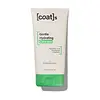What's inside
What's inside
 Key Ingredients
Key Ingredients

No key ingredients
 Benefits
Benefits

 Concerns
Concerns

 Ingredients Side-by-side
Ingredients Side-by-side

Water
Skin ConditioningCaprylic/Capric Triglyceride
MaskingTheobroma Cacao Seed Butter
EmollientCetearyl Alcohol
EmollientCetyl Esters
EmollientCera Alba
EmollientGlycerin
HumectantPolysorbate 60
EmulsifyingSorbitan Stearate
EmulsifyingEucalyptus Globulus Leaf Oil
PerfumingRosmarinus Officinalis Leaf Extract
AntimicrobialHumulus Lupulus Extract
AntimicrobialChamomilla Recutita Flower Extract
MaskingPropylene Glycol
HumectantPhenoxyethanol
PreservativePanthenol
Skin ConditioningBenzoic Acid
MaskingDehydroacetic Acid
PreservativeSorbitol
HumectantLimonene
PerfumingEthylhexylglycerin
Skin ConditioningPolyaminopropyl Biguanide
PreservativeCitric Acid
BufferingSodium Hydroxide
BufferingWater, Caprylic/Capric Triglyceride, Theobroma Cacao Seed Butter, Cetearyl Alcohol, Cetyl Esters, Cera Alba, Glycerin, Polysorbate 60, Sorbitan Stearate, Eucalyptus Globulus Leaf Oil, Rosmarinus Officinalis Leaf Extract, Humulus Lupulus Extract, Chamomilla Recutita Flower Extract, Propylene Glycol, Phenoxyethanol, Panthenol, Benzoic Acid, Dehydroacetic Acid, Sorbitol, Limonene, Ethylhexylglycerin, Polyaminopropyl Biguanide, Citric Acid, Sodium Hydroxide
Water
Skin ConditioningGlycerin
HumectantCetearyl Alcohol
EmollientPolysorbate 60
EmulsifyingPhenoxyethanol
PreservativeCarbomer
Emulsion StabilisingBenzyl Alcohol
PerfumingNiacinamide
SmoothingDisodium EDTA
Sodium Hyaluronate
HumectantXanthan Gum
EmulsifyingSodium Lauroyl Lactylate
EmulsifyingSodium Hydroxide
BufferingCeramide NP
Skin ConditioningCeramide AP
Skin ConditioningPhytosphingosine
Skin ConditioningCholesterol
EmollientEthylhexylglycerin
Skin ConditioningCeramide EOP
Skin Conditioning
 Reviews
Reviews

Ingredients Explained
These ingredients are found in both products.
Ingredients higher up in an ingredient list are typically present in a larger amount.
Cetearyl alcohol is a mixture of two fatty alcohols: cetyl alcohol and stearyl alcohol. It is mainly used as an emulsifier. Emulsifiers help prevent the separation of oils and products. Due to its composition, it can also be used to thicken a product or help create foam.
Cetearyl alcohol is an emollient. Emollients help soothe and hydrate the skin by trapping moisture.
Studies show Cetearyl alcohol is non-toxic and non-irritating. The FDA allows products labeled "alcohol-free" to have fatty alcohols.
This ingredient is usually derived from plant oils such as palm, vegetable, or coconut oils. There is debate on whether this ingredient will cause acne.
Due to the fatty acid base, this ingredient may not be Malassezia folliculitis safe.
Learn more about Cetearyl AlcoholEthylhexylglycerin (we can't pronounce this either) is commonly used as a preservative and skin softener. It is derived from glyceryl.
You might see Ethylhexylglycerin often paired with other preservatives such as phenoxyethanol. Ethylhexylglycerin has been found to increase the effectiveness of these other preservatives.
Glycerin is already naturally found in your skin. It helps moisturize and protect your skin.
A study from 2016 found glycerin to be more effective as a humectant than AHAs and hyaluronic acid.
As a humectant, it helps the skin stay hydrated by pulling moisture to your skin. The low molecular weight of glycerin allows it to pull moisture into the deeper layers of your skin.
Hydrated skin improves your skin barrier; Your skin barrier helps protect against irritants and bacteria.
Glycerin has also been found to have antimicrobial and antiviral properties. Due to these properties, glycerin is often used in wound and burn treatments.
In cosmetics, glycerin is usually derived from plants such as soybean or palm. However, it can also be sourced from animals, such as tallow or animal fat.
This ingredient is organic, colorless, odorless, and non-toxic.
Glycerin is the name for this ingredient in American English. British English uses Glycerol/Glycerine.
Learn more about GlycerinPhenoxyethanol is a preservative that has germicide, antimicrobial, and aromatic properties. Studies show that phenoxyethanol can prevent microbial growth. By itself, it has a scent that is similar to that of a rose.
It's often used in formulations along with Caprylyl Glycol to preserve the shelf life of products.
Polysorbate 60 is used to help stabilize products. It is a surfactant and emulsifier. These properties help keep ingredients together in a product. Surfactants help reduce surface tension between ingredients with different states, such as liquids and solids. Emulsifiers help prevent oils and waters from separating.
Polysorbate 60 is sorbitol-based and created from the ethoxylation of sorbitan. Ethoxylation is a chemical reaction used to add ethylene oxide. Sorbitan is a the dehydrated version of sorbitol, a sugar found in fruits.
In this case, the 60 comes from reacting 60 units of ethylene oxide with sorbitan.
Polysorbates are commonly used in medicine and foods.
Learn more about Polysorbate 60Sodium Hydroxide is also known as lye or caustic soda. It is used to adjust the pH of products; many ingredients require a specific pH to be effective.
In small amounts, sodium hydroxide is considered safe to use. However, large amounts may cause chemical burns due to its high alkaline.
Your skin has a natural pH and acid mantle. This acid mantle helps prevent harmful bacteria from breaking through. The acid mantle also helps keep your skin hydrated.
"Alkaline" refers to a high pH level. A low pH level would be considered acidic.
Learn more about Sodium HydroxideWater. It's the most common cosmetic ingredient of all. You'll usually see it at the top of ingredient lists, meaning that it makes up the largest part of the product.
So why is it so popular? Water most often acts as a solvent - this means that it helps dissolve other ingredients into the formulation.
You'll also recognize water as that liquid we all need to stay alive. If you see this, drink a glass of water. Stay hydrated!
Learn more about Water